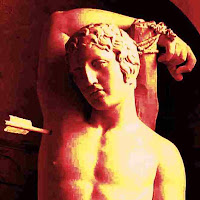San Sebastiano de Sodoma
How did Saint Sebastian die?
Arrows pierced his throat and thigh
which only knew, before that time,
the dolors of a concubine.
Near above him, hardly over,
hovered hid gold martyr's crown.
Even Mary from Her tower
of heaven leaned a little down
and as She leaned, She raised a corner
of a cloud through which to spy.
Sweetly troubled Mary murmured
as She watched the arrows fly.
And as the cup that was profaned
gave up its sweet, intemperate wine,
all the golden bells of heaven
praised an emperor's concubine.
Mary, leaning from her tower
of heaven, dropped a tiny flower
but, privately, she must have wondered
if it were indeed quite wise to
San Sebastiano de Sodoma
Comment Saint Sébastien est mort ?
De flèches perçant cuisses et gorge
qui de douleurs, ne connaissaient
que celles douces du bien-aimé.
Juste au-dessus, légère, planait
du martyr la couronne dorée.
Même Marie, de son clocher
Céleste Se pencha doucement
et Elle souleva un fragment
de nuage pour espionner.
Doucement troublée Marie murmurait
observant les flèches voler.
Comme le calice profané
rejetait son vin immodéré,
du ciel, toutes les cloches dorées
louaient l’amant d'un empereur.
De sa tour céleste, Marie penchée,
lâcha une toute petite fleur
pourtant Elle dut se demander
si c'était vraiment averti
d’admettre ce fils au Paradis ?
Tennessee Williams (1911-1983) - Translation by Sebastien G.
Tennessee Williams qui venait d'une "haute Eglise" Episcopale et converti au Catholicisme, était habitué aux images et la légende de St Sébastien. Son poème "San Sebastiano de Sodoma" de 1948 honore à la fois l'histoire religeuse de St Sébastien ainsi que la tradition qui a fait du saint une icône de l'homosexualité.
source: Suddenly Last Summer - St. Sebastian
Judith Thompson a montré que Williams voyait en l'histoire de St. Sébastien les thèmes du sexe et de la mort. Elle écrit que :
Source: Judith Thompson : Tennessee Williams' Plays: Memory, Myth, and Symbol.
Links: glbtq>literature>Williams Tennessee
---> Previously on §ebastianus --->
Tennessee Williams - Suddenly last Summer
Joseph L. Mankiewicz - Suddenly last Summer
---> HELP! --->
Une traduction en français plus "officielle" serait le bienvenu!
Thank you for sending any more "official" translation into French


Aucun commentaire:
Enregistrer un commentaire